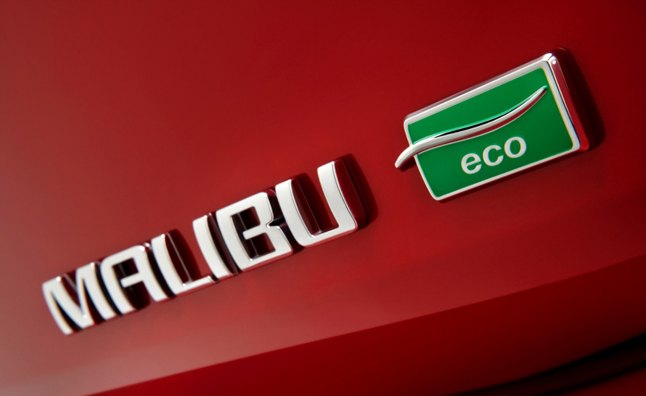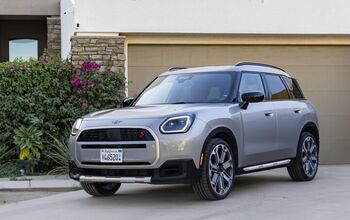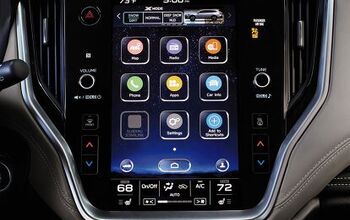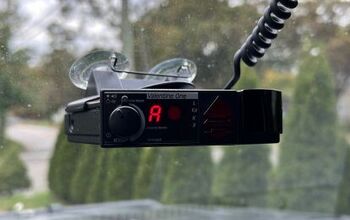Feature: GM's EAssist Hybrid Bet Doesn't Pay Off

Currently available on three models, GM’s eAssist technology is a product and packaging gamble the automaker has made that does not appear to be paying off. While the first two Buick models to receive the mild-hybrid system received modest praise, the new Chevy Malibu Eco has drawn so much criticism it was recently named “the most disliked vehicle of 2012” according to Fortune magazine.
The impact of that title, not to mention all the bad press that’s led up to it, can’t be understated. The reputation, and sales, of an entire lifecycle of Malibu models (the Malibu being one of GM’s largest volume products) is hanging in the balance.
Most successful hybrids, like the Toyota Prius, use a full-hybrid system, which means that electric motors can provide enough power to move the vehicle, and generally speaking the improvement in fuel economy is more significant. The eAssist system, however, makes due with a more basic layout, with the electric motor assisting the gasoline engine, but never actually powering the car by itself.
So why did General Motors avoid the traditional route and create a mild-hybrid, instead of a full one?
VERSATILITY AT THE HEART OF eASSIST?
“We looked at what was coming in electrification in the next 10 years or so and there’s a lot of full hybrids, electric vehicles and range extended EVs coming, and we found that there are still significant cost premiums for those vehicles,” explained Stephen Poulos, chief engineer of eAssist. “We wanted to see how we could take some of those functions, and get it down to a very basic system that we can adapt to otherwise conventional powertrains.”
GM says that even without using a complicated full-hybrid system, a vehicle with eAssist can get 15-25 percent better fuel economy than their vehicles that aren’t equipped with eAssist.
“Our goal was to be able to integrate with the minimum amount of tear-up,” said Polous in regards to eAssist’s development. “It’s something that is fairly adaptable to different vehicles.”
So far, GM has managed to put eAssist into family-sized sedans like the Chevrolet Malibu Eco, Buick Lacrosse and Buick Regal. These cars all fit in segments where comfort, cargo space and fuel economy are important factors. One key feature of the eAssist system is its size, being small enough to have little effect on trunk space and still allow for folding seats – at least on one side.
The components that make up eAssist are chosen due to their ability to be easily implemented into an established vehicle. eAssist is made up of just a 15-kW belt-driven motor/generator as well as a compact 115-v lithium ion battery pack. All those electric components are paired with a conventional 2.4-L four-cylinder engine, and a slightly modified six-speed automatic.
“The scaling required to make a full-hybrid system is huge, and very costly.” Poulos says. With eAssist, GM is making a versatile powertrain that could theoretically move into other vehicles.
IS A MILD HYBRID REALLY THE BETTER CHOICE?
All this means that the development and assembly of eAssist vehicles should be cheaper, and should make eAssist vehicles less expensive than a full-hybrid rival. However, the Malibu Eco, which is equipped with the eAssist system, isn’t making a strong case for itself.
At $25,235, the Chevrolet Malibu Eco is $465 cheaper than the Kia Optima Hybrid, $615 cheaper than the Hyundai Sonata Hybrid, $755 cheaper than the Toyota Camry Hybrid and $3,540 cheaper than the Ford Fusion Hybrid, all of which use full-hybrid systems. While the Malibu does cost less than all its rivals, with the exception of the Ford, the difference is not significant.
In terms of efficiency, eAssist is also on rocky ground. In regards to weight, a mild-hybrid is supposed to be lighter, which would make the engine work less, and improve efficiency.
For example, in the Toyota Camry Hybrid, the full hybrid system uses a large 105-kW electric motor and a 245-volt Nickel-Metal Hydride battery (compared to eAssists’ 15kW motor and 115-volt battery pack.) These two items in the Camry take up precious space and required unique engineering in order to place them optimally in the car without disturbing weight balance. Since the Malibu Eco uses a smaller motor, and a smaller battery, it should weigh less, and doesn’t need as much re-tooling to get the system in there.
Unfortunately, while the system may weigh less, the car does not. While the Malibu Eco is 100 lbs lighter than the Ford Fusion Hybrid, it’s also 130 lbs heavier than the Optima Hybrid, 42 to 163 lbs heavier than the Hyundai Sonata Hybrid, and 179 to 203 lbs heavier than the Toyota Camry Hybrid.
This helps identify the final issue with eAssist: fuel economy. The Malibu Eco is officially rated at 25 mpg in the city and 37 mpg on the highway, earning a combined rating of 29 mpg. The competition, on the other hand, gets significantly better ratings all around. The Kia Optima Hybrid, and Hyundai Sonata Hybrid are both rated at 35/40 mpg city/highway, with a combined rating of 37 mpg. The Ford Fusion Hybrid is rated at 41/36 mpg city/highway and 39 mpg combined. Finally, the Toyota Camry Hybrid is rated at 43/39 mpg city/highway with a combined rating of 41 mpg.
That’s a huge difference, and it should come as no surprise that GM seems to be straying away from calling these cars hybrids.
eASSIST VS BASE POWERTRAINS
Polous explains that eAssist is really not aiming to compete with these products. “We’re trying to sell the base vehicle,” said Polous “we’re purposely trying not to go head-to-head against these full hybrid systems.”
That’s a tough argument to make when the pricing is so close to the full hybrid competition.
Rather, says Polous, with eAssist GM is looking to redefine a base powertrain. “The mission of eAssist is to upgrade, or replace the base powertrain,” he says. And while that might be true on the new Buick LaCrosse, it’s a $2,000 option on the Regal and is sold as an entirely separate Chevy Malibu Eco model, which will gain a non-hybrid 2.5-liter base model this year.
As for the non-hybrid models of the Malibu Eco’s competition, they all get around 28 mpg combined, except for the Ford Fusion, which gets 23 mpg. That means that the Malibu has better fuel economy by 1 mpg against the base Camry, Optima and Sonata, and 6 mpg more than the Fusion.
That sounds like a win for the Malibu, but then again, compare the prices of these vehicles. The Malibu Eco at $25,235 is $4,035 more than the base Optima, $4,340 more than the base Sonata, $4,530 more than the Ford Fusion, and $3,180 more than the Toyota Camry.
Perhaps one area where GM can succeed with its eAssist technology is in attracting buyers hesitant to adopt hybrid technology. In fact, GM has even gone so far as to avoid any use of the word hybrid in its literature. Still, with the Toyota Prius now ranked as one of the world’s best selling cars this year, consumer opinions about hybrid technology appear to have already changed.
WHAT THE CRITICS SAY
GM’s mild-hybrid gamble does not appear to be paying off, not for the consumer, and not for the automaker either. As mentioned, it has taken a beating in the press, including here at AutoGuide where we wrote, “Priced at $25,995 the Malibu Eco isn’t exactly a value leader, especially when you consider the hybrid Sonata and Camry both get considerably better fuel economy and cost about the same.” None of this can be good for sales.
Reviews of the Buick models proved more favorable, though as we pointed out in our Regal eAssist review, that is due in part to a lack of competition in the segment.
The upcoming non-eAssist Malibu may prove to be the ultimate test for the mild-hybrid system. The gasoline-exclusive Malibu will use a 2.5-liter engine, and if the EPA fuel ratings are comparable to the eAssist model, it could spell death for the mild-hybrid system, and could foreshadow the upcoming strategy for the Buick vehicles as well.

Sami has an unquenchable thirst for car knowledge and has been at AutoGuide for the past six years. He has a degree in journalism and media studies from the University of Guelph-Humber in Toronto and has won multiple journalism awards from the Automotive Journalist Association of Canada. Sami is also on the jury for the World Car Awards.
More by Sami Haj-Assaad





































Comments
Join the conversation
GM's eAssist technology is the most practical and cost-effective form of vehicle electrification, and the only electric drive technology that makes good economic sense, given the current level of technology in batteries and electric drive motors. The fundamental concept behind eAssist is brilliant - it is a system designed to capture the energy from decelerating a vehicle, and controlling its speed on downhill stretches of roads - a significant amount energy that is otherwise normally completely lost in the form of heat - and return this energy back to the drive system in the form of an electric assist to the vehicle's engine. The net results are lower fuel consumption, reduced emissions, increased mpg, longer driving range per tank, time saved from less frequent fuel stops, and More Money in your bank account. For a real life illustration of the advantages of GMs eAssist system - compare my 2012 Buick Regal with eAssist - to the same car without the eAssist system (rated 19 mpg city and 25 mpg highway) - the eAssist version is rated at 25 mpg city and 36 mpg highway. I am actually getting 26 mpg city and 37 mpg highway, and a full-tank highway driving range of up to 450 miles with just a 15.3 gallon tank! - Very impressive for a car that I was able to get a great deal on a a left-over 2012 model in Sept of 2013. I must add that proper driving technique is required to get the most out of the eAssist system, including smooth starts and smooth, precise application of the throttle (gas pedal) to provide just the amount of power needed to get the vehicle up to the desired speed, and then once there - using precise throttle application to control and maintain the vehicles speed, as opposed to applying excessive amounts of throttle, followed by excessive use of the brakes. Motorists who drive by alternately mashing the gas and brake pedals will not be able to realize the immense benefits of the eAssist system. Another big benefit of the eAssist system is that, at the hands of a skilled driver it will also significantly extend the life of the vehicle's brake system components thus saving More Money in operational costs. When driven properly a vehicle with eAssist can easily get over 100,000 miles on the original brakes before service is required. In fact the savings in brake system service costs alone over the first 100,000 miles of ownership will more than completely cover the entire cost of the eAssist system - with the increased mpg and reduced fuel costs being the very thick layer of icing on the cake. So when factoring in the cost savings of an eAssist system you must include the substantial savings in brake system service costs along with the reduction in fuel costs and the combination of both means that the cost of the eAssist system can be rapidly returned to the owner within the first 12 to 24 months of ownership - as opposed to the 10 to 12 years needed to recoup the higher cost of a full hybrid system. Keeping the cost of the eAssist system low is the fact that its key components - the electric motor and the battery pack - are smaller and much less expensive than those used in a full hybrid vehicle. Two other great features of eAssist are that it works seamlessly and it does not require any plug-in charging. Essentially eAssist provides the most cost-effective aspect of a full hybrid vehicle - regenerative braking - at far less cost than a full hybrid system. Additional advantages of GM's eAssist system are: - Auto-Stop feature - When you come to a stop - the gas engine shuts off saving even more gas (this is a Big Plus when you get stuck in a traffic jam!). When you lift your foot from the brake - the compact motor/generator unit, which replaces the alternator and like the alternator is connected to the engine via a belt drive - quickly, smoothly and quietly re-starts the engine. This also helps to Reduce Vehicle Emissions - especially in bumper-to-bumper city driving conditions. - Seamless Operation - You hardly even notice that the eAssist system is there. Even when the gas engine shuts off at a stop, the special 110 Volt eAssist battery pack (which is continually maintained in a charged state from coasting and braking) keeps all of the accessories running - including the radio, lights, heater/AC, navigation, etc. - And last but not least: NO RANGE ANXIETY! Go wherever you want and fill the gas tank as needed like you would with any standard gas powered car. And with good driving skills - you'll be able to get the maximum benefits out of the eAssist system and as a result - you'll get Great Fuel Mileage. In summary - GM's eAssist system provides the most cost effective way to reduce fuel consumption, reduce emissions and extend the brake system service life of ANY vehicle - all great reasons why it should be incorporated into EVERY vehicle!
GM's eAssist technology is the most practical and cost-effective form of vehicle electrification, and the only electric drive technology that makes good economic sense, given the current level of technology in batteries and electric drive motors. The fundamental concept behind eAssist is brilliant - it is a system designed to capture the energy from decelerating a vehicle, and controlling its speed on downhill stretches of roads - a significant amount energy that is otherwise normally completely lost in the form of heat - and return this energy back to the drive system in the form of an electric assist to the vehicle's engine. The net results are lower fuel consumption, reduced emissions, increased mpg, longer driving range per tank, time saved from less frequent fuel stops, and More Money in your bank account. For a real life illustration of the advantages of GMs eAssist system - compare my 2012 Buick Regal with eAssist - to the same car without the eAssist system (rated 19 mpg city and 25 mpg highway) - the eAssist version is rated at 25 mpg city and 36 mpg highway. I am actually getting 26 mpg city and 37 mpg highway, and a full-tank highway driving range of up to 450 miles with just a 15.3 gallon tank! - Very impressive for a car that I was able to get a great deal on as a left-over 2012 model in Sept of 2013. I must add that proper driving technique is required to get the most out of the eAssist system, including smooth starts and smooth, precise application of the throttle (gas pedal) to provide just the amount of power needed to get the vehicle up to the desired speed, and then once there - using precise throttle application to control and maintain the vehicles speed, as opposed to applying excessive amounts of throttle, followed by excessive use of the brakes. Motorists who drive by alternately mashing the gas and brake pedals will not be able to realize the immense benefits of the eAssist system. Another big benefit of the eAssist system is that, at the hands of a skilled driver it will also significantly extend the life of the vehicle's brake system components thus saving More Money in operational costs. When driven properly a vehicle with eAssist can easily get over 100,000 miles on the original brakes before service is required. In fact the savings in brake system service costs alone over the first 100,000 miles of ownership will more than completely cover the entire cost of the eAssist system - with the increased mpg and reduced fuel costs being the very thick layer of icing on the cake. So when factoring in the cost savings of an eAssist system you must include the substantial savings in brake system service costs along with the reduction in fuel costs and the combination of both means that the cost of the eAssist system can be rapidly returned to the owner within the first 12 to 24 months of ownership - as opposed to the 10 to 12 years needed to recoup the higher cost of a full hybrid system. Keeping the cost of the eAssist system low is the fact that its key components - the electric motor and the battery pack - are smaller and much less expensive than those used in a full hybrid vehicle. Two other great features of eAssist are that it works seamlessly and it does not require any plug-in charging. Essentially eAssist provides the most cost-effective aspect of a full hybrid vehicle - regenerative braking - at far less cost than a full hybrid system. Additional advantages of GM's eAssist system are: - Auto-Stop feature - When you come to a stop - the gas engine shuts off saving even more gas (this is a Big Plus when you get stuck in a traffic jam!). When you lift your foot from the brake - the compact motor/generator unit, which replaces the alternator and like the alternator is connected to the engine via a belt drive - quickly, smoothly and quietly re-starts the engine. This also helps to Reduce Vehicle Emissions - especially in bumper-to-bumper city driving conditions. - Seamless Operation - You hardly even notice that the eAssist system is there. Even when the gas engine shuts off at a stop, the special 110 Volt eAssist battery pack (which is continually maintained in a charged state from coasting and braking) keeps all of the accessories running - including the radio, lights, heater/AC, navigation, etc. - And last but not least: NO RANGE ANXIETY! Go wherever you want and fill the gas tank as needed like you would with any standard gas powered car. And with good driving skills - you'll be able to get the maximum benefits out of the eAssist system and as a result - you'll get Great Fuel Mileage. In summary - GM's eAssist system provides the most cost effective way to reduce fuel consumption, reduce emissions and extend the brake system service life of ANY vehicle - all great reasons why it should be incorporated into EVERY vehicle!